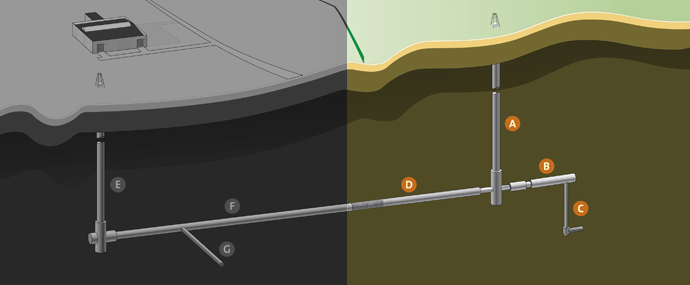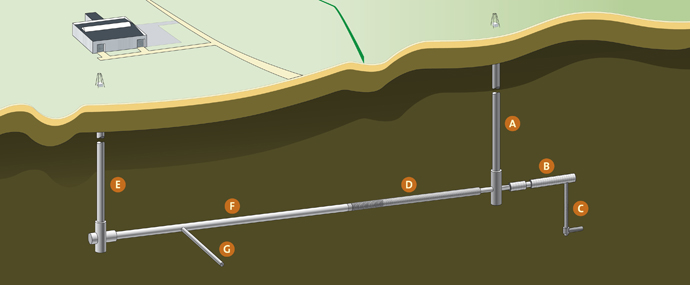From manual to industrial
The HADES underground research laboratory is situated at a depth of 225 metres in the Boom Clay Formation and can be reached through two access shafts, each equipped with a lift. The main gallery linking these two shafts is about 150 metres in length.
HADES was built in two phases. The first section was completed in the 1980s and excavation proceeded manually for the most part. Between 1997 and 2007 the laboratory was extended using industrial techniques.
1980-1987: Pioneering work

(A) 1980-1982: First shaft
Excavation work began in 1980. Engineers were concerned that the poorly indurated clay deep underground would close relatively quickly during excavation. The soil and the clay were therefore frozen down to a depth of 240 metres.
(B) 1983-1984: First gallery
A first gallery (26 metres long and 3.5 metres in diameter) was excavated manually in frozen clay at a depth of 225 metres. Cast iron rings support the excavated gallery.
(C) 1984: Experimental shaft and gallery
The creep rate of the clay after thawing was found to be relatively low. As a test, a shaft and gallery were excavated without freezing the clay. The support provided by concrete blocks was just as effective as cast iron rings, but was less expensive. The experimental shaft was then sealed off as part of the RESEAL experiment.
(D) 1987: Second gallery (known as the test drift)
The expertise gained was applied on a larger scale in 1987 to extend the underground laboratory. A gallery 51 m long and 3.5 m in diameter was excavated in unfrozen clay and supported with concrete blocks. Shortly thereafter, French engineers carried out tests with a different type of support, a sliding steel rib system, over a length of 15 metres.
1997-2007: Extension of HADES

1995 marked the start of a new phase as construction of a shaft and galleries using industrial engineering methods got under way.
(E) Second shaft
The first step was to construct a second access shaft using industrial techniques.
(F) 2001-2002: Connecting gallery
An 80-metre Connecting gallery was excavated between the second shaft and the existing section of the laboratory in six weeks. This was the first time that a gallery had been excavated in plastic clay at a depth of 225 metres using an industrial tunnelling technique.
(G) 2007: PRACLAY gallery
This gallery is 45 metres long with a diameter of 1.9 metres and lies perpendicular to the Connecting gallery. It was also excavated using industrial tunnelling techniques and is named after the PRACLAY experiment.
